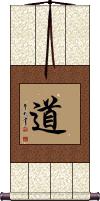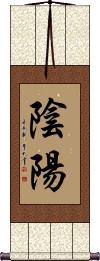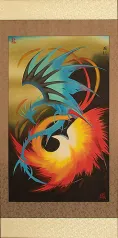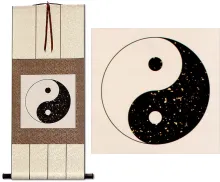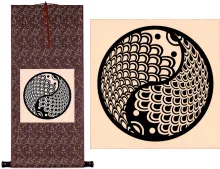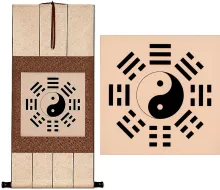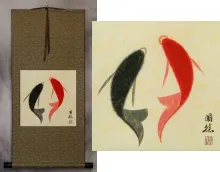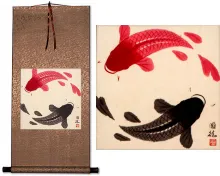Many custom options...
And formats...

The name Yin and Yang in Chinese / Japanese...
Buy a Yin and Yang calligraphy wall scroll here!
Personalize your custom “Yin and Yang” project by clicking the button next to your favorite “Yin and Yang” title below...
Daoism / Taoism
Literally: The Way or Road
道 is the character “dao” which is sometimes written as “tao” but pronounced like “dow” in Mandarin.
道 is the base of what is known as “Taoism.” If you translate this literally, it can mean “the way” or “the path.”
Dao is believed to be that which flows through all things and keeps them in balance. It incorporates the ideas of yin and yang (e.g. there would be no love without hate, no light without dark, no male without female.)
The beginning of Taoism can be traced to a mystical man named
Lao Zi (604-531 BC), who followed, and added to the teachings of Confucius.
More about Taoism / Daoism here.
Note that this is pronounced “dou” and sometimes “michi” when written alone in Japanese but pronounced “do” in word compounds such as Karate-do and Bushido. It's also “do” in Korean.
Alternate translations and meanings: road, way, path; truth, principle province.
Important Japanese note: In Japanese, this will generally be read with the road, way, or path meaning. Taoism is not as popular or well-known in Japan so Daoist/Taoist philosophy is not the first thing a Japanese person will think of when they read this character.
See our Taoism Page
Daoism / Taoism
道教 is the title often used in both Chinese and Japanese to describe the beliefs or religion of Taoism / Daoism.
The first character is simply “dao” and the second character can be translated as “teachings,” “faith” or “doctrine.”
Yin Yang
陰陽 literally means yin and yang in written form (versus the common yin-yang symbol). The first character has the element of the moon, while the second character has the element of the sun so that you can see, even in written form, they suggest the balance of opposites (of night and day). You could also translate this title as “sun and moon.”
Note: This title is often misspelled as Ying Yang instead of Yin Yang.
See Also: Taoism
This in-stock artwork might be what you are looking for, and ships right away...
Gallery Price: $168.00
Your Price: $92.88
Not the results for yin and yang that you were looking for?
Below are some entries from our dictionary that may match your yin and yang search...
| Characters If shown, 2nd row is Simp. Chinese |
Pronunciation Romanization |
Simple Dictionary Definition |
陰陽 阴阳 see styles |
yīn yáng yin1 yang2 yin yang inyou(p); onmyou; onyou / inyo(p); onmyo; onyo いんよう(P); おんみょう; おんよう |
More info & calligraphy: Yin Yangcosmic dual forces; yin and yang; sun and moon, etc.; (place-name) In'you yin and yang |
陰陽家 阴阳家 see styles |
yīn yáng jiā yin1 yang2 jia1 yin yang chia inyouka; onyouke; onmyouke / inyoka; onyoke; onmyoke いんようか; おんようけ; おんみょうけ |
School of Yin-Yang of the Warring States Period (475-221 BC) founded by Zou Yan 鄒衍|邹衍[Zou1 Yan3] (1) (See 陰陽道) diviner (esp. of the Yin and Yang system); sorcerer; exorcist; medium; (2) (hist) School of Yin-yang (China); School of Naturalists |
陰 阴 see styles |
yīn yin1 yin hoto ほと |
overcast (weather); cloudy; shady; Yin (the negative principle of Yin and Yang); negative (electric.); feminine; moon; implicit; hidden; genitalia (archaism) female private parts; female genitals; (surname) Kage Shade, dark, the shades, the negative as opposed to the positive principle, female, the moon, back, secret. In Buddhism it is the phenomenal, as obscuring the true nature of things; also the aggregation of phenomenal things resulting in births and deaths, hence it is used as a translation like 蘊 q.v. for skandha, the 五陰 being the five skandhas or aggregates. |
九流 see styles |
jiǔ liú jiu3 liu2 chiu liu kuru |
the nine schools of thought, philosophical schools of the Spring and Autumn and Warring States Periods (770-220 BC), viz Confucians 儒家[Ru2 jia1], Daoists 道家[Dao4 jia1], Yin and Yang 陰陽家|阴阳家[Yin1 yang2 jia1], Legalists 法家[Fa3 jia1], Logicians 名家[Ming2 jia1], Mohists 墨家[Mo4 jia1], Diplomats 縱橫家|纵横家[Zong4 heng2 jia1], Miscellaneous 雜家|杂家[Za2 jia1], and Agriculturalists 農家|农家[Nong2 jia1] 九漏 idem | 孔. |
八綱 八纲 see styles |
bā gāng ba1 gang1 pa kang |
(TCM) the eight principal syndromes (used to differentiate pathological conditions): yin and yang, exterior and interior, cold and heat, hypofunction and hyperfunction |
乾坤 see styles |
qián kūn qian2 kun1 ch`ien k`un chien kun kenkon けんこん |
yin and yang; heaven and earth; the universe heaven and earth; universe |
陰陽五行 see styles |
inyougogyou; onyougogyou / inyogogyo; onyogogyo いんようごぎょう; おんようごぎょう |
(yoji) the cosmic dual forces (yin and yang) and the five elements (metal, wood, water, fire and earth) in Chinese cosmology |
兩儀 两仪 see styles |
liǎng yí liang3 yi2 liang i |
heaven and earth; yin and yang |
二気 see styles |
niki にき |
two forces (of yin and yang) |
虛損 虚损 see styles |
xū sǔn xu1 sun3 hsü sun |
(TCM) consumptive disease, chronic deficiency disorder due to impaired function of inner organs, deficiency of qi, blood, yin and yang; asomethingenia |
陰陽道 see styles |
onmyoudou; onyoudou / onmyodo; onyodo おんみょうどう; おんようどう |
Onmyōdō; way of Yin and Yang; occult divination system based on the Taoist theory of the five elements |
陰陽和合 see styles |
inyouwagou / inyowago いんようわごう |
the harmony of yin and yang energies |
道 see styles |
dào dao4 tao dou / do どう |
More info & calligraphy: Daoism / Taoism(1) (abbreviation) (See 道・みち・1) road; path; street; route; (2) (See 道・みち・5) way; set of practices; rules for conducting oneself; (3) (abbreviation) (in Japanese schools) (See 道徳教育) moral education; (4) Buddhist teachings; (5) Taoism; (6) administrative region of Japan (Hokkaido); (7) (hist) administrative region of Japan (Tokaido, Tosando, etc.); (8) province (administrative region of Korea); (9) circuit (administrative region of China); (10) (hist) province (Tang-era administrative region of China); (personal name) Wataru mārga. A way, road; the right path; principle, Truth, Reason, Logos, Cosmic energy; to lead; to say. The way of transmigration by which one arrives at a good or bad existence; any of the six gati, or paths of destiny. The way of bodhi, or enlightenment leading to nirvāṇa through spiritual stages. Essential nirvāṇa, in which absolute freedom reigns. For the eightfold noble path v. 八聖道.; The two Ways: (1) (a) 無礙道 or 無間道 The open or unhindered way, or the way of removing all obstacles or intervention, i. e. all delusion; (b) 解脫道 the way of release, by realization of truth. (2) (a) 難行道 The hard way of "works", i. e. by the six pāramitā and the disciplines. (b) 易行道 the easy way salvation, by the invocation of Amitābha. (3) (a) 有漏道 The way of reincarnation or mortality; (b) 無漏 the enlightened way of escape from the miseries of transmigration. (4) (a) 教道 The way of instruction; (b) 證道 the way of realization. (5) The two lower excretory organs. |
陽 阳 see styles |
yáng yang2 yang you / yo よう |
More info & calligraphy: Yako / Minami(noun - becomes adjective with の) (1) (the) positive; (2) (ant: 陰・2) yang (in Chinese divination); (3) (See 陰に陽に) the open; visible place; public place; (personal name) Yōji The side on which the sun shines, the sun, heat, this life, positive, masculine, dynamic, etc. |
仙人 see styles |
xiān rén xian1 ren2 hsien jen sennin せんにん |
More info & calligraphy: Sennin(1) immortal mountain wizard (in Taoism); mountain man (esp. a hermit); (2) one not bound by earthly desires or the thoughts of normal men; (surname, given name) Sennin seer |
道教 see styles |
dào jiào dao4 jiao4 tao chiao doukyou / dokyo どうきょう |
More info & calligraphy: Daoism / TaoismTaoism; Daoism; (personal name) Michinori Taoism. The teaching of the right way, i.e. of Buddhism. |
魂魄 see styles |
hún pò hun2 po4 hun p`o hun po konpaku こんぱく |
More info & calligraphy: Ghost / Soul / Spiritsoul; spirit; ghost Animus and anima; the spiritual nature or mind, and the animal soul; the two are defined as mind and body or mental and physical, the invisible soul inhabiting the visible body, the former being celestial, the latter terrestrial. |
爻 see styles |
yáo yao2 yao kou / ko こう |
the solid and broken lines of the eight trigrams 八卦[ba1 gua4], e.g. ☶ (See 卦) yao (line representing yin or yang that comprises one third of a trigram) |
三尸 see styles |
sanshi さんし |
(See 庚申待) the three worms (in Taoism); worms that inhabit the human gut and, on the eve of the 57th day of the sexagenary cycle, ascend to heaven during one's sleep to report on one's wrongdoings |
三教 see styles |
sān jiào san1 jiao4 san chiao sankyou; sangyou / sankyo; sangyo さんきょう; さんぎょう |
the Three Doctrines (Daoism, Confucianism, Buddhism) (1) Shinto, Buddhism and Confucianism; the three religions; (2) Confucianism, Buddhism and Taoism; (3) Buddhism, Shinto and Christianity; (given name) Mitsunori The three teachings, i.e. 儒, 佛 (or 釋), and 道Confucianism, Buddhism, and Taoism; or, 孔, 老, 釋 Confucianism, Taoism (aIso known as 神敎), and Buddhism. In Japan they are Shinto, Confucianism, and Buddhism. In Buddhism the term is applied to the three periods of Śākyamuni's own teaching, of which there are several definitions: (1) The Jiangnan 南中 School describe his teaching as (a) 漸progressive or gradual; (b) 頓 immediate, i.e. as one whole, especially in the 華嚴經; and (c) 不定 or indeterminate. (2) 光統 Guangtong, a writer of the Iater Wei dynasty, describes the three as (a) 漸 progressive for beginners, i.e. from impermanence to permanence, from the void to reality, etc.; (b) 頓 immediate for the more advanced; and (c) 圓complete, to the most advanced, i.e. the Huayan as above. (3) The 三時敎q.v. (4) The 南山 Southern school deals with (a) the 性空of Hīnayāna; (b) 相空of Mahāyāna; and (c) 唯識圓 the perfect idealism. v. 行事鈔中 4. Tiantai accepts the division of 漸, 頓, and 不定 for pre-Lotus teaching, but adopts 漸 gradual, 頓 immediate, and 圓 perfect, with the Lotus as the perfect teaching; it also has the division of 三藏敎 , 通敎 , and 別敎 q.v. |
五葷 五荤 see styles |
wǔ hūn wu3 hun1 wu hun gokun ごくん |
(Buddhism etc) the five forbidden pungent vegetables: leek, scallion, garlic, rape and coriander (See 五辛) five pungent roots (in Buddhism or Taoism) idem 五辛. |
五辛 see styles |
wǔ xīn wu3 xin1 wu hsin goshin ごしん |
see 五葷|五荤[wu3 hun1] (See 五葷) five pungent roots (in Buddhism or Taoism) The five forbidden pungent roots, 五葷 garlic, three kinds of onions, and leeks; if eaten raw they are said to cause irritability of temper, and if eaten cooked, to act as an aphrodisiac; moreover, the breath of the eater, if reading the sutras, will drive away the good spirits. |
仙客 see styles |
senkaku せんかく |
(1) (rare) (See 仙人・1) immortal mountain wizard (in Taoism); (2) (rare) (See 鶴) crane (bird) |
修真 see styles |
xiū zhēn xiu1 zhen1 hsiu chen shuuma / shuma しゅうま |
to practice Taoism; to cultivate the true self through spiritual exercises (personal name) Shuuma |
僊人 仙人 see styles |
sennin せんにん |
(1) immortal mountain wizard (in Taoism); mountain man (esp. a hermit); (2) person not bound by earthly desires |
六気 see styles |
rokki; rikki; rikuki ろっき; りっき; りくき |
(1) yin, yang, wind, rain, darkness, light; (2) cold, heat, dryness, dampness, wind, fire; (3) six emotions (joy, anger, sorrow, pleasure, love, hate) |
地仙 see styles |
dì xiān di4 xian1 ti hsien chisen ちせん |
(See 仙人・せんにん・1) earthly immortal (in Taoism) (地行仙) Earth-immortals, or genī, one of the classes of ṛṣis; i. e. bhūdeva = Brahman. |
天仙 see styles |
tiān xiān tian1 xian1 t`ien hsien tien hsien tensen てんせん |
immortal (esp. female); deity; fairy; Goddess; fig. beautiful woman (See 仙人・せんにん・1) heavenly immortal (in Taoism); (given name) Tensen deva-ṛṣi, or devas and rsis, or immortals. Nāgārjuna gives ten classes of ṛṣis whose lifetime is 100, 000 years, then they are reincarnated. Another category is fivefold: 天仙 deva-ṛṣis in the mountains round Sumeru: 神仙 spirit-ṛṣis who roam the air: 人仙 humans who have attained the powers of immortals; 地仙 earth ṛṣis, subterranean; 鬼仙 pretas, or malevolent ṛṣis. |
太陰 太阴 see styles |
tài yīn tai4 yin1 t`ai yin tai yin taiin / tain たいいん |
the Moon (esp. in Daoism) (1) the Moon; (2) (See 小陰) the greater yin (in yin-yang) |
小陰 see styles |
shouin / shoin しょういん |
the lesser yin (within yin-yang) |
Click here for more yin and yang results from our dictionary
The following table may be helpful for those studying Chinese or Japanese...
| Title | Characters | Romaji (Romanized Japanese) | Various forms of Romanized Chinese | |
| Daoism Taoism | 道 | michi / -do | dào / dao4 / dao | tao |
| Daoism Taoism | 道教 | doukyou / dokyo | dào jiào / dao4 jiao4 / dao jiao / daojiao | tao chiao / taochiao |
| Yin Yang | 陰陽 阴阳 | in you / inyou / in yo | yīn yáng / yin1 yang2 / yin yang / yinyang | |
| In some entries above you will see that characters have different versions above and below a line. In these cases, the characters above the line are Traditional Chinese, while the ones below are Simplified Chinese. | ||||
Successful Chinese Character and Japanese Kanji calligraphy searches within the last few hours...
